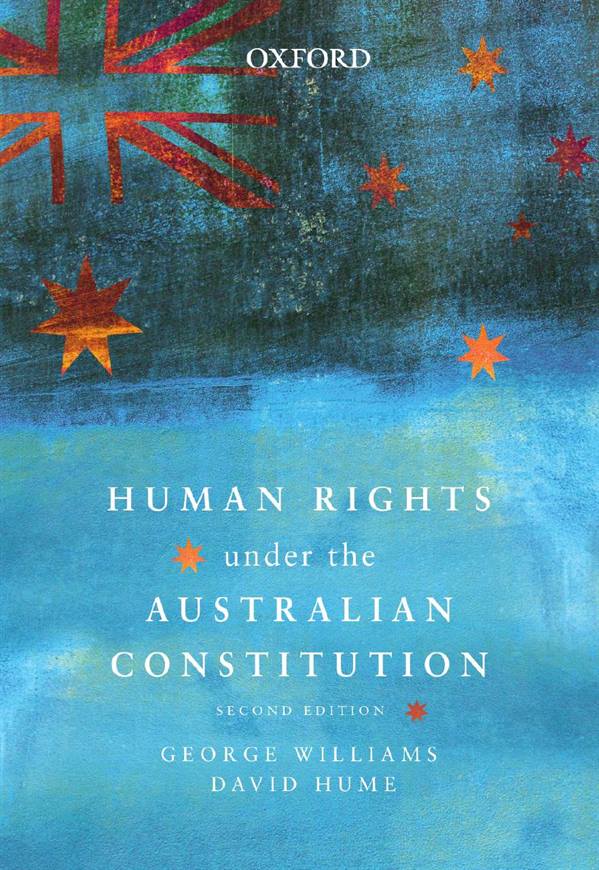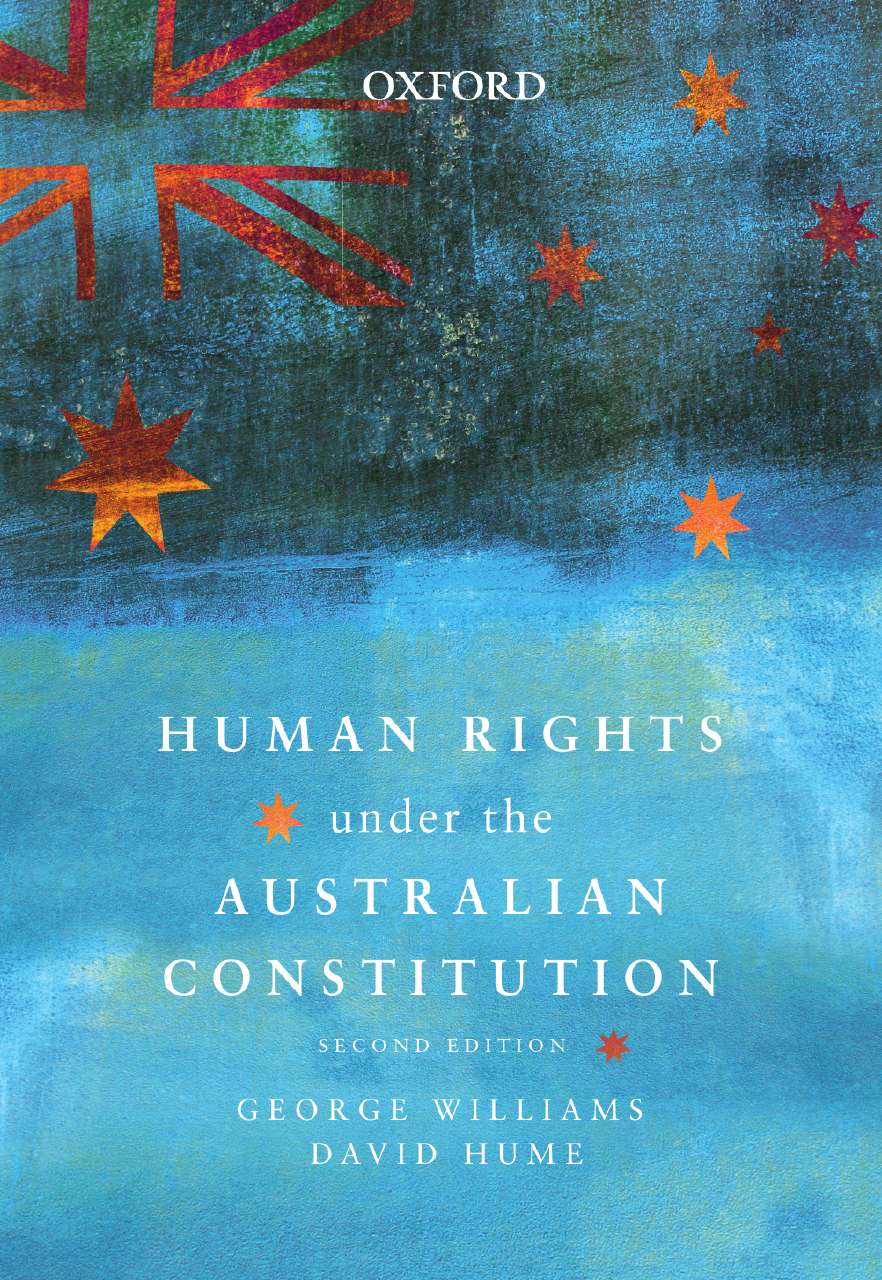Human Rights under the Australian Constitution ebook

Human Rights under the Australian Constitution ebook
|
ISBN: |
9780195588422 |
|
Binding: |
Ebook |
|
Published: |
22 Nov 2013 |
|
Availability: |
Available
|
|
Series: |
$99.95 AUD
$113.99 NZD
Add To Cart Add To CartOther options: Paperback $117.95 AUD $135.99 NZD
Request an inspection copyDescription
Human Rights under the Australian Constitution is the leading text on how the Australian Constitution protects human rights. It provides a comprehensive overview and analysis of the key public law principles, including the full range of express and implied rights in the Australian Constitution. It does this within a broader context, including the drafting and origins of the Australian Constitution and the interaction of constitutional principles with the common law, statute law and international law.
The Australian position is examined in light of developments in comparable legal systems, including the United States, Canada, the United Kingdom and New Zealand. The result is a thorough work that examines in context areas of law of great importance to Australian democracy, including freedom of speech, the right to vote, freedom of religion, the acquisition of property on just terms, judicial independence and the right to a fair trial.
The book intersperses discussion and analysis of existing doctrine with critique and where appropriate suggestions for legal development. This second edition updates the material in the first edition to reflect subsequent developments and expands the discussion in many areas, such as judicial power, which have increasingly drawn High Court attention.
Tertiary (wholly Australian) Scholarly Resource Category winner - Educational Publishing Awards Australia 2014
Contents
1 Human rights in Australia
1 Introduction
2 What are human rights?
3 The legal protection of human rights in Australia
3.1 State and territory law
3.2 Federal statute law
3.3 Commonwealth parliamentary processes
4 International law
4.1 Shaping the interpretation of statutes
4.2 Informing the development of the common law
4.3 Providing extra-legal facts which can have legal consequences
4.4 Affecting procedural powers and obligations?
5 The common law as a source of rights and freedoms
5.1 Statutory construction and human rights
5.2 Statutory construction: the principle of legality
5.2.1 Overview
5.2.2 Breadth and depth of the principle of legality
5.2.3 The future of the principle of legality
5.3 Are there ‘fundamental rights and freedoms’ which cannot be abrogated?
5.4 The common law and the Constitution
6 The state of human rights in Australia
2 The drafting of the Australian Constitution
1 Introduction
2 The making of the Australian Constitution
3 The influence of comparative models
4 Human rights at the constitutional conventions
5 Andrew Inglis Clark’s draft constitution
6 Clauses 46 and 81: freedom of religion
7 Clause 65: trial by jury
8 Equal protection of the laws, and due process of law
9 The framers, human rights, and cl 110
9.1 Responsible, not republican, government
9.2 Maintaining discriminatory laws
10 The issue of race in other clauses
11 The rights of women in the Australian Constitution
12 Constitutional amendments and human rights
13 Underlying principles
3 Constitutional interpretation
1 Introduction
2 Literalism and the Engineers Case
2.1 The Engineers Case
2.2 Literalism, legalism and human rights
2.3 Challenges to the Engineers Case
2.3.1 Extrinsic factors in constitutional interpretation
2.3.2 Substance, not just form
2.3.3 Inconsistent applications of literalism
2.3.4 Literalism and the construction of express constitutional guarantees
3 History and constitutional interpretation
3.1 The Convention debates as an aid to interpretation
3.2 Limiting constitutional rights by use of the Convention debates
3.3 Originalism and dynamic development
4 Popular sovereignty
5 ‘Abstraction’ from power by constitutional guarantees
6 Human rights principles in constitutional interpretation
4 The text and structure of the Australian Constitution
1 Introduction
2 Rights protections in the Australian Constitution
3 Federalism
3.1 Federalism as a human rights protection
3.2 Implications from federalism
4 The separation of powers
4.1 Limits on ‘legislative power’
4.2 Limits on executive power
4.3 The separation of judicial power
5 Representative government
6 Responsible government
6.1 The nature and constitutional basis of responsible government
6.2 Responsible government and the protection of rights
7 The rule of law
7.1 Implications from the rule of law
8 Proportionality
8.1 Factors bearing on proportionality
9 ‘Freedoms‘ or ‘immunities’ and ‘rights’ or ‘individual rights’
9.1 Consequences
9.2 The doctrinal basis
10 Remedies for ‘breach’ of the Constitution
5 Freedom of political communication
1 Introduction
2 The development of the implied freedom of political communication
2.1 The Murphy supernova
2.2 The High Court discerns and develops the freedom
2.3 Securing the basis of the freedom
2.4 Post-Lange development of the freedom
3 The systemic basis of the implied freedom
3.1 Narrower basis than other free speech protections
3.2 Not an ‘individual right’ to speak
3.3 Foreign jurisprudence is of limited assistance
3.4 Operates at least as a ‘vertical’ immunity
3.5 The status of the person who expresses the communication
3.6 The severity of the burden on receipt of information is relevant
4 Political communications: ‘coverage’ of the implied freedom
4.1 Exclusions: non-political communications
4.2 Exclusions: non-federal communications
4.3 Inclusions: communications on federal political issues
4.4 Categorical exclusions?
4.5 Are some political communications more important than others?
5 ‘Effective burden’ on the implied freedom
5.1 A greater role for this limb?
5.2 Is there a need for a pre-existing common law or statutory freedom?
5.3 Direct and incidental burdens
6 ‘Compatible ends’
6.1 Laws advancing interests other than the constitutionally prescribed systems
6.2 Laws advancing the constitutional systems
6.2.1 Laws advancing aspects of the constitutionally prescribed systems other than freedom of communication
6.2.2 Laws advancing the constitutionally prescribed systems by enhancing freedom of communication
6.3 The future of compatible ends
7 Proportionality
8 Derivative freedoms: political movement and political association
6 The right to vote and equality of voting power
1 Introduction
2 Commonwealth Parliament’s power to prescribe the franchise
3 Could s 41 protect a right to vote?
4 ‘Directly chosen by the people’ and universal suffrage
4.1 The development of ss 7 and 24 as the basis of universal suffrage: Roach v Electoral Commissioner
4.2 Conditional exceptions to universal suffrage: Rowe v Electoral Commissioner
4.3 Roach and Rowe: two fundamental debates about judicial review of rights
5 Equality of voting power
7 Civil rights
1 Introduction
2 Religious rights
2.1 Overview of s 116
2.2 The ‘making of law’
2.3 ‘For’
2.4 ‘Establishing’ any religion
2.5 ‘Prohibiting the free exercise of any religion’
2.6 ‘Religion’
3 Rights of out-of-state residents
3.1 Section 117 and equality protections in the Australian Constitution 272
3.2 The narrow approach to s 117
3.3 The broad approach to s 117
3.4 The future of s 117
8 Economic rights
1 Introduction
2 Acquisition of property on just terms
2.1 Overview
2.2 ‘Acquisition’: taking
2.3 ‘Acquisition’: acquisition of an interest in property
2.4 ‘Property’
2.5 ‘Just terms’
2.6 ‘For any purpose in respect of which the Parliament has power to make laws’
2.7 Application to the states and territories
2.8 Laws which acquire property but are not covered by s 51(xxi)
3 Freedom of interstate trade, commerce and intercourse
3.1 The rise and fall of the ‘individual rights’ approach
3.2 The post-Cole v Whitfield approach
3.3 The freedom of interstate intercourse
4 Civil conscription
9 Judicial power
1 Introduction
2 Judicial review
2.1 Judicial review of constitutional validity
2.2 Judicial review of Commonwealth public power
2.3 Judicial review of state public power
3 Exclusively judicial powers
3.1 Punishment consequent on a determination of guilt
3.2 Detention authorised otherwise than by judicial order
3.3 Overturning an exercise of Commonwealth judicial power
3.4 Retrospective criminal laws
4 Trial by jury 31
4.1 Overview of s 80
4.2 ‘Trial … on indictment’
4.3 ‘Trial … by jury’
4.3 ‘Shall’ be by jury
4.4 ‘Offence’
5 ‘Due process’ in the exercise of judicial power
5.1 Independence and impartiality
5.2 Processes or functions repugnant to Ch III
5.2.1 Reasons for decision
5.2.2 The open court principle
5.2.3 ‘Vague’ or ‘polycentric’ standards
5.2.4 Procedural fairness
Authors
George Williams AO is the Anthony Mason Professor, a Scientia Professor and the Foundation Director of the Gilbert + Tobin Centre of Public Law at the Faculty of Law, University of New South Wales. He is an Australian Research Council Laureate Fellow and has written and edited leading texts including Australian Constitutional Law and Theory and The Oxford Companion to the High Court of Australia. He has also appeared as a barrister in the High Court of Australia in cases on freedom of speech, freedom from racial discrimination, review of government action and the rule of law. As chair of the Victorian Human Rights Consultation Committee, he helped bring about Australia’s first State bill of rights, the Victorian Charter of Human Rights and Responsibilities. He is a well-known media commentator on legal issues, and is a columnist for the Sydney Morning Herald.
David Hume is a barrister at the New South Wales Bar. Previously, he worked in the Australian Government Solicitor’s Constitutional Litigation Unit representing the Commonwealth in High Court constitutional litigation and as an Associate to Chief Justice Gleeson. He has a Master of Laws from Harvard, has studied at McGill Law School and has degrees in Law and Philosophy from the University of New South Wales.
Reviews
“George Williams and David Hume have done a splendid job not only in infusing principle and system into the constitutional human rights jurisprudence which the High Court has developed but in explaining and critiquing that constitutional human rights jurisprudence within the broader sweep of the constitutional jurisprudence of the High Court. The difficulty in producing a work of this nature lies in finding a balance between the abstract and the concrete, the ideas and the cases, the theory and the practice, the critical and the descriptive. To err in either direction is to limit the work's utility to a section of its potential readership and with it, the work's potential to influence. George and David have achieved a balance that is about right: organising the material thematically; dipping lightly into the cases; and separating quite clearly the doctrine from the commentary. The result is a book that is likely to prove useful to those who are practising lawyers as much as to those with an interest in human rights. The fourteen years have been worth the wait. The second edition of Human Rights Under the Australian Constitution is a significant contribution to the inevitably overlapping fields of constitutional and human rights scholarship in Australia.” -- The Honourable Justice Stephen Gageler
Reviews of the first edition of Human Rights under the Australian Constitution:
Williams’ project … is rigorously researched, intelligently articulated and compellingly argued … Williams leaves no doubt as to his impressive grasp of the Constitution and constitutional doctrine, of comparative instruments and principles, and of the possibilities suggested by the High Court’s existing jurisprudence for a more coherent and effective framework for the constitutional protection of human rights.
(1999) 21 Adelaide Law Review 139
The book is written in clear and elegant prose and the arguments are tightly structured and well developed. Williams displays an intimate knowledge of constitutional law and his detailed analysis of High Court cases is extremely impressive and well researched. Also impressive is his extensive use of comparative material, especially from the United States and Canada.
(1999) 23 Melbourne University Law Review 817
